Abstract
Using tunicamycin, we have investigated the role of glycoproteins in membrane transport. Tunicamycin is a glucosamine-containing antibiotic that specifically inhibits dolichol pyrophosphate-mediated glycosylation of asparaginyl residues of glycoproteins. Inhibition of protein glycosylation in chick embryo fibroblasts by tunicamycin or other inhibitors of glycosylation resulted in defective transport of glucose, uridine, and amino acid analogs (alpha-aminoisobutyrate and cycloleucine). The defect in glucose transport is accompanied by decreased glucose metabolism, as determined by rates of CO2 and lactate production. In contrast, tunicamycin treatment did not affect other membrane-associated processes, such as secretion of fibronectin and procollagen, uptake of glucose by passive diffusion, Na+/K+ ATPase and adenylate cyclase activities, or stimulation of adenylate cyclase by prostaglandin and cholera toxin. Two glucose/glycosylation-regulated membrane proteins with apparent subunit molecular weights of 95,000 and 75,000 were induced by tunicamycin treatment. Our results indicate that glycoprotein glycosylation is required for membrane transport.
Full text
PDF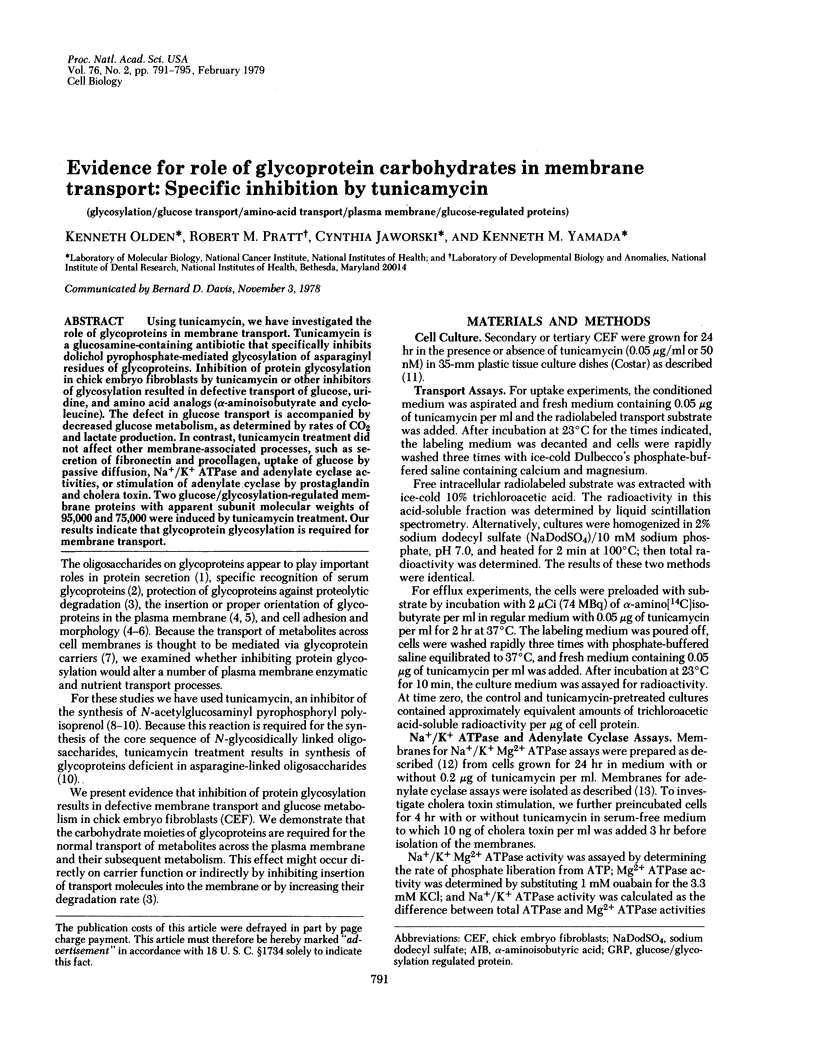
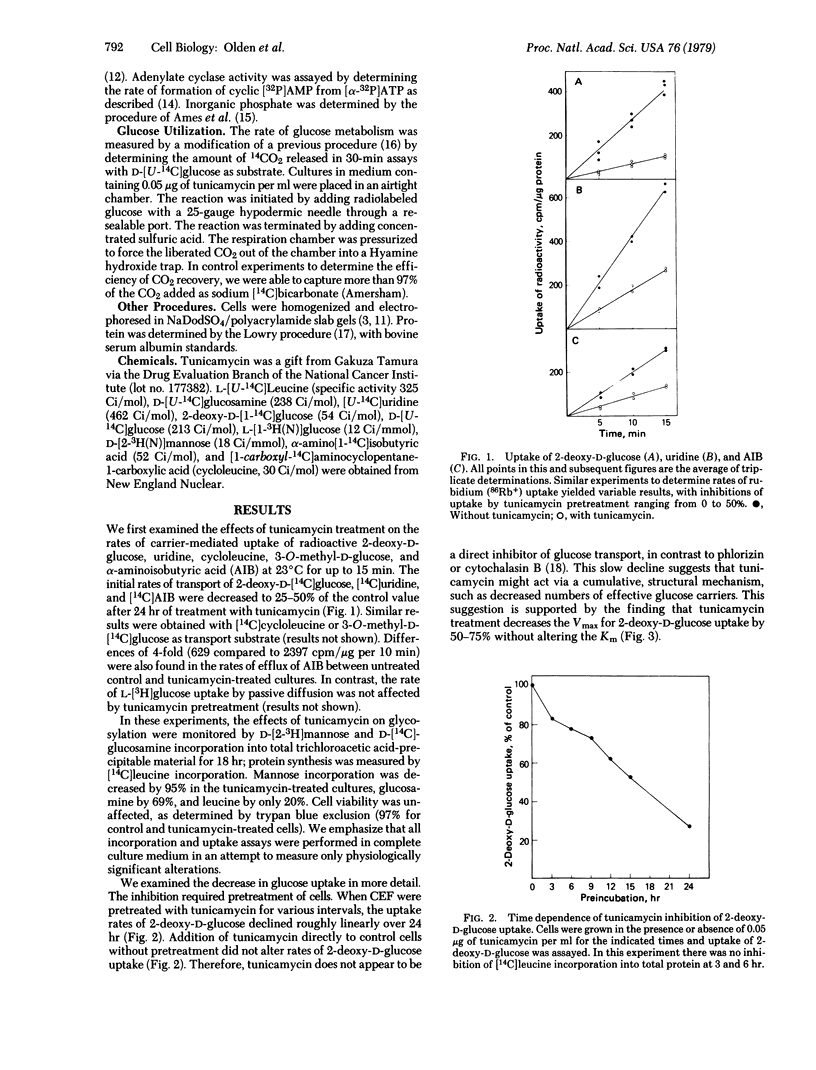
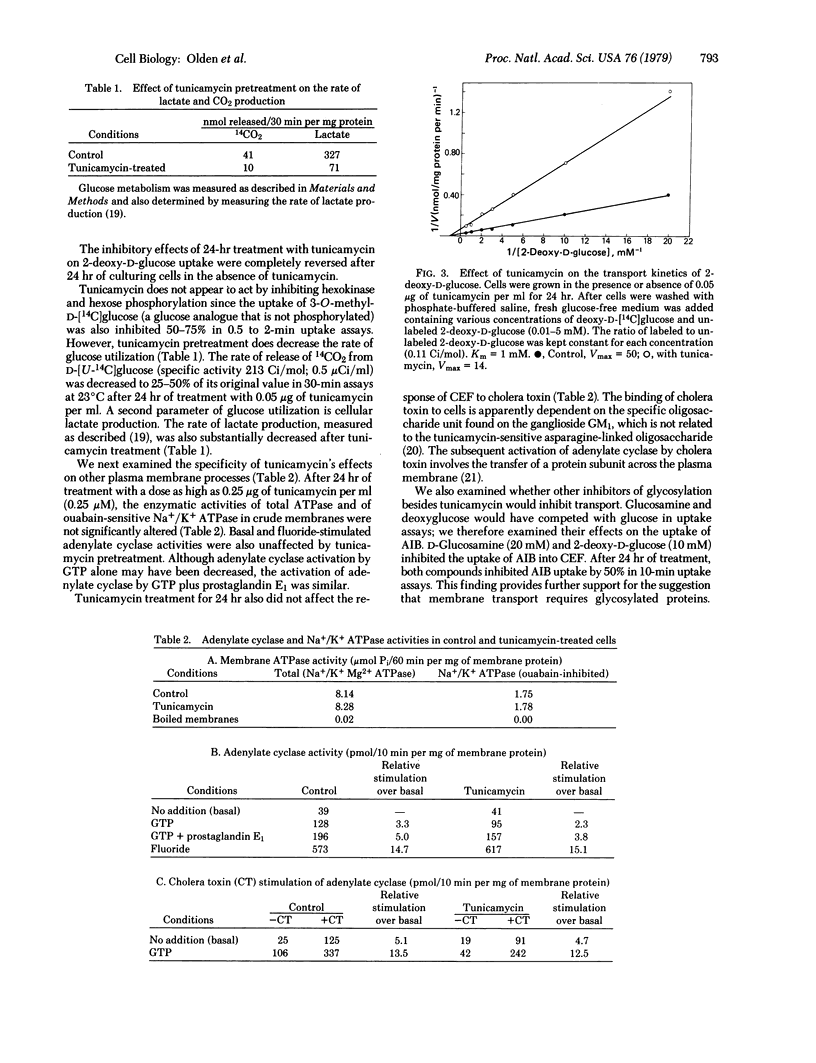
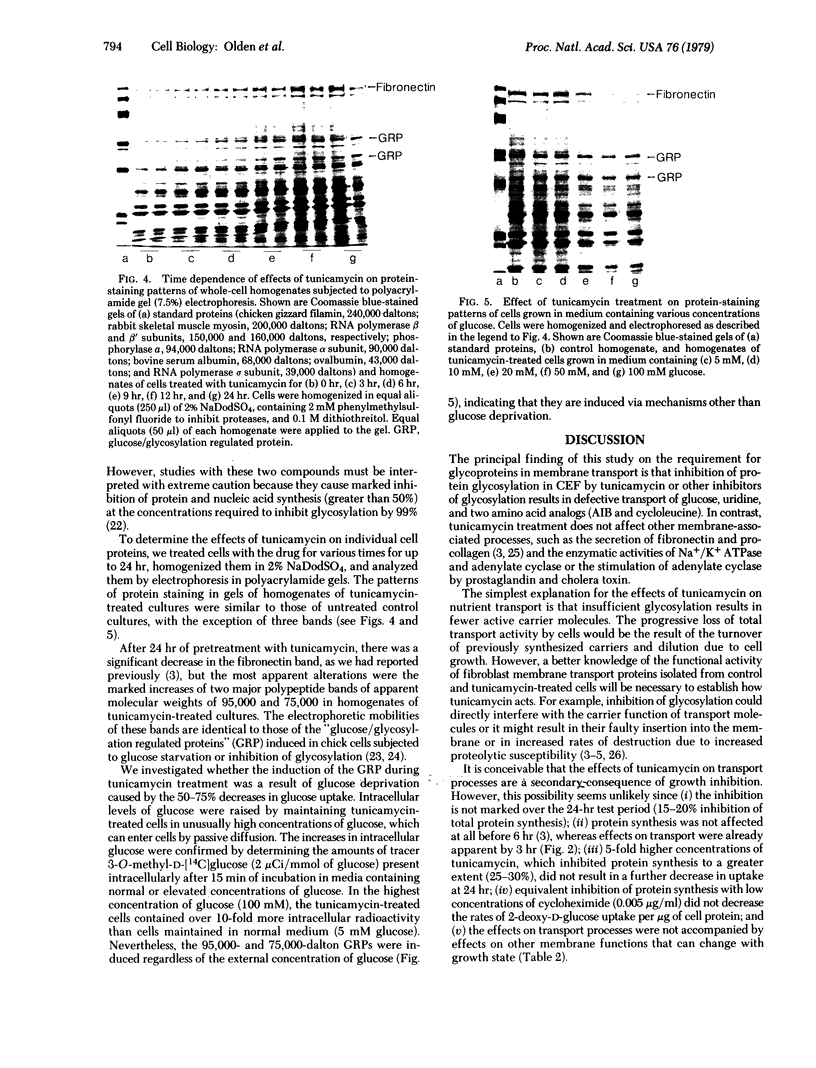
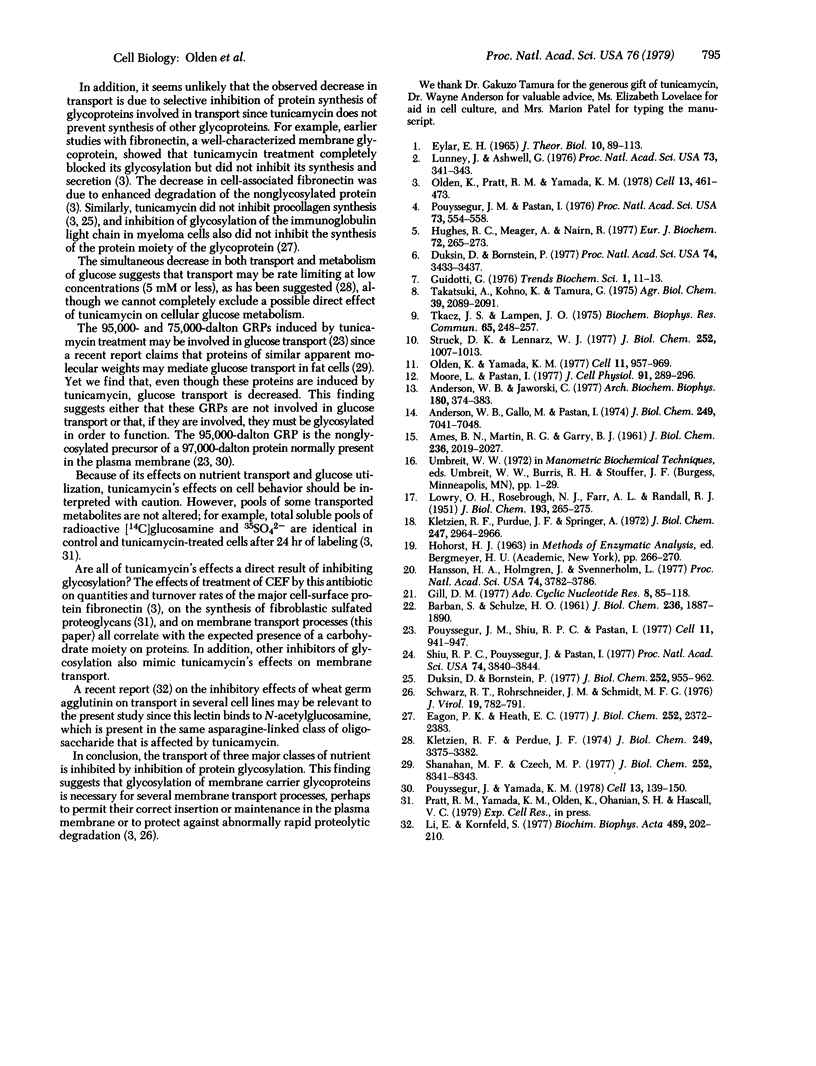
Images in this article
Selected References
These references are in PubMed. This may not be the complete list of references from this article.
- AMES B. N., MARTIN R. G., GARRY B. J. The first step of histidine biosynthesis. J Biol Chem. 1961 Jul;236:2019–2026. [PubMed] [Google Scholar]
- Anderson W. B., Gallo M., Pastan I. Adenylate cyclase activity in fibroblasts transformed by Kirsten or Moloney sarcoma viruses. Decreased activity and loss of response to prostaglandin E1. J Biol Chem. 1974 Nov 25;249(22):7041–7048. [PubMed] [Google Scholar]
- Anderson W. B., Jaworski C. J. Modulation of adenylate cyclase activity of fibroblasts by free fatty acids and phospholipids. Arch Biochem Biophys. 1977 Apr 30;180(2):374–383. doi: 10.1016/0003-9861(77)90051-0. [DOI] [PubMed] [Google Scholar]
- BARBAN S., SCHULZE H. O. The effects of 2-deoxyglucose on the growth and metabolism of cultured human cells. J Biol Chem. 1961 Jul;236:1887–1890. [PubMed] [Google Scholar]
- Duksin D., Bornstein P. Changes in surface properties of normal and transformed cells caused by tunicamycin, an inhibitor of protein glycosylation. Proc Natl Acad Sci U S A. 1977 Aug;74(8):3433–3437. doi: 10.1073/pnas.74.8.3433. [DOI] [PMC free article] [PubMed] [Google Scholar]
- Duksin D., Bornstein P. Impaired conversion of procollagen to collagen by fibroblasts and bone treated with tunicamycin, an inhibitor of protein glycosylation. J Biol Chem. 1977 Feb 10;252(3):955–962. [PubMed] [Google Scholar]
- Eagon P. K., Heath E. C. Glycoprotein biosynthesis in myeloma cells. Characterization on nonglycosylated immunoglobulin light chain secreted in presence of 2-deoxy-D-glucose. J Biol Chem. 1977 Apr 10;252(7):2372–2383. [PubMed] [Google Scholar]
- Eylar E. H. On the biological role of glycoproteins. J Theor Biol. 1966 Jan;10(1):89–113. doi: 10.1016/0022-5193(66)90179-2. [DOI] [PubMed] [Google Scholar]
- Gandini Attardi D., Martini G., Mattoccia E., Tocchini-Valentini G. P. Effect of Xenopus laevis oocyte extract on supercoiled simian virus 40 DNA: formation of complex DNA. Proc Natl Acad Sci U S A. 1976 Feb;73(2):554–558. doi: 10.1073/pnas.73.2.554. [DOI] [PMC free article] [PubMed] [Google Scholar]
- Gill D. M. Mechanism of action of cholera toxin. Adv Cyclic Nucleotide Res. 1977;8:85–118. [PubMed] [Google Scholar]
- Hansson H. A., Holmgren J., Svennerholm L. Ultrastructural localization of cell membrane GM1 ganglioside by cholera toxin. Proc Natl Acad Sci U S A. 1977 Sep;74(9):3782–3786. doi: 10.1073/pnas.74.9.3782. [DOI] [PMC free article] [PubMed] [Google Scholar]
- Hughes R. C., Meager A., Nairn R. Effect of 2-deoxy-D-glucose on the cell-surface glycoproteins of hamster fibroblasts,. Eur J Biochem. 1977 Jan;72(2):265–273. doi: 10.1111/j.1432-1033.1977.tb11249.x. [DOI] [PubMed] [Google Scholar]
- Kletzien R. F., Perdue J. F., Springer A. Cytochalasin A and B. Inhibition of sugar uptake in cultured cells. J Biol Chem. 1972 May 10;247(9):2964–2966. [PubMed] [Google Scholar]
- Kletzien R. F., Perdue J. F. Sugar transport in chick embryo fibroblasts. II. Alterations in transport following transformation by a temperature-sensitive mutant of the Rous sarcoma virus. J Biol Chem. 1974 Jun 10;249(11):3375–3382. [PubMed] [Google Scholar]
- LOWRY O. H., ROSEBROUGH N. J., FARR A. L., RANDALL R. J. Protein measurement with the Folin phenol reagent. J Biol Chem. 1951 Nov;193(1):265–275. [PubMed] [Google Scholar]
- Li E., Kronfeld S. Effects of wheat germ agglutinin on membrane transport. Biochim Biophys Acta. 1977 Sep 5;469(2):202–210. doi: 10.1016/0005-2736(77)90182-1. [DOI] [PubMed] [Google Scholar]
- Lunney J., Ashwell G. A hepatic receptor of avian origin capable of binding specifically modified glycoproteins. Proc Natl Acad Sci U S A. 1976 Feb;73(2):341–343. doi: 10.1073/pnas.73.2.341. [DOI] [PMC free article] [PubMed] [Google Scholar]
- Moore L., Pastan I. Regulation of intracellular calcium in chick embryo fibroblast: calcium uptake by the microsomal fraction. J Cell Physiol. 1977 May;91(2):289–296. doi: 10.1002/jcp.1040910213. [DOI] [PubMed] [Google Scholar]
- Olden K., Pratt R. M., Yamada K. M. Role of carbohydrates in protein secretion and turnover: effects of tunicamycin on the major cell surface glycoprotein of chick embryo fibroblasts. Cell. 1978 Mar;13(3):461–473. doi: 10.1016/0092-8674(78)90320-3. [DOI] [PubMed] [Google Scholar]
- Olden K., Yamada K. M. Mechanism of the decrease in the major cell surface protein of chick embryo fibroblasts after transformation. Cell. 1977 Aug;11(4):957–969. doi: 10.1016/0092-8674(77)90307-5. [DOI] [PubMed] [Google Scholar]
- Pouysségur J., Shiu R. P., Pastan I. Induction of two transformation-sensitive membrane polypeptides in normal fibroblasts by a block in glycoprotein synthesis or glucose deprivation. Cell. 1977 Aug;11(4):941–947. doi: 10.1016/0092-8674(77)90305-1. [DOI] [PubMed] [Google Scholar]
- Pouysségur J., Yamada K. M. Isolation and immunological characterization of a glucose-regulated fibroblast cell surface glycoprotein and its nonglycosylated precursor. Cell. 1978 Jan;13(1):139–140. doi: 10.1016/0092-8674(78)90145-9. [DOI] [PubMed] [Google Scholar]
- Schwarz R. T., Rohrschneider J. M., Schmidt M. F. Suppression of glycoprotein formation of Semliki Forest, influenza, and avian sarcoma virus by tunicamycin. J Virol. 1976 Sep;19(3):782–791. doi: 10.1128/jvi.19.3.782-791.1976. [DOI] [PMC free article] [PubMed] [Google Scholar]
- Shanahan M. F., Czech M. P. Purification and reconstitution of the adipocyte plasma membrane D-glucose transport system. J Biol Chem. 1977 Dec 10;252(23):8341–8343. [PubMed] [Google Scholar]
- Shiu R. P., Pouyssegur J., Pastan I. Glucose depletion accounts for the induction of two transformation-sensitive membrane proteinsin Rous sarcoma virus-transformed chick embryo fibroblasts. Proc Natl Acad Sci U S A. 1977 Sep;74(9):3840–3844. doi: 10.1073/pnas.74.9.3840. [DOI] [PMC free article] [PubMed] [Google Scholar]
- Struck D. K., Lennarz W. J. Evidence for the participation of saccharide-lipids in the synthesis of the oligosaccharide chain of ovalbumin. J Biol Chem. 1977 Feb 10;252(3):1007–1013. [PubMed] [Google Scholar]
- Tkacz J. S., Lampen O. Tunicamycin inhibition of polyisoprenyl N-acetylglucosaminyl pyrophosphate formation in calf-liver microsomes. Biochem Biophys Res Commun. 1975 Jul 8;65(1):248–257. doi: 10.1016/s0006-291x(75)80086-6. [DOI] [PubMed] [Google Scholar]




